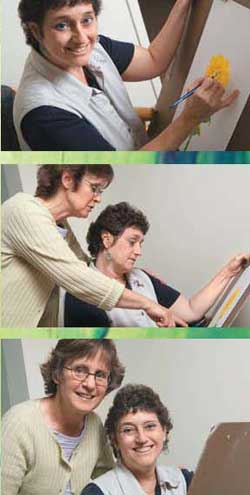Healing Art
Rogel Cancer Center's Art Therapy Program Offers Relief Through Expression
Cynthia Castrodale arrives for her session with inspiration in hand: a coffee table book of Georgia O'Keefe paintings.

Margaret Nowak, the Rogel Cancer Center's art therapist, has Castrodale's latest work ready and waiting. It's a solitary yellow flower holding its own against the stark white page. It's bright and bold, the petals bearing a slight resemblance to a lion's mane.
Cancer leaves many legacies. For Castrodale, following a year of art therapy, it has brought her an unexpected passion for painting.
"I had never put paint to paper before. It never occurred to me," said Castrodale, a world traveler who had long admired great works of art. "But painting is very peaceful. It has been good for me, especially in such a tumultuous time."
At the Rogel Cancer Center, thanks to the generous support of donors including the Robert Bruce Dunlap Endowment, Margaret Nowak leads patients like Castrodale through exercises that use art as a means of coping and an avenue of self-expression.
Art therapy has been shown to reduce pain and anxiety in cancer patients, according to a small study in the Journal of Pain and Symptom Management. During a four-month study involving 50 patients, researchers observed a decrease in pain, tiredness, depression, anxiety, drowsiness, lack of appetite and shortness of breath following art therapy sessions.
"Art therapy creates a positive emotional state. For some of the patients I work with, it's the first time they've been in a state of joyful relaxation in a long time," Nowak said. "It might just be for that hour, but if you've been in a constant state of high anxiety, an hour is a really wonderful gift."
At the end of many sessions, Nowak asks her patients to tell her about their work. Although she never imposes her own interpretations, she guides the discussion to help patients think about why they have drawn a particular image or chosen a certain color.
Anyone can participate in art therapy, regardless of experience or artistic ability. Nowak said patients sometimes are surprised by what they create. Projects range from painting to jewelry to journal making.
"You merely need to be interested to see where art takes you," Nowak said. "Patients might be in chemotherapy for three or four hours, but with art therapy, they're having so much fun, they can't believe how quickly the time flew by.
If you are a patient -- or family member -- at the U-M Rogel Cancer Center and would like to arrange for Art Therapy, please call 877-907-0859.
Continue reading the Fall, 2007 issue of Thrive.
